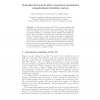Free Online Productivity Tools
i2Speak
i2Symbol
i2OCR
iTex2Img
iWeb2Print
iWeb2Shot
i2Type
iPdf2Split
iPdf2Merge
i2Bopomofo
i2Arabic
i2Style
i2Image
i2PDF
iLatex2Rtf
Sci2ools
91
Voted
DAGM
2005
Springer
2005
Springer
Goal-Directed Search with a Top-Down Modulated Computational Attention System
In this paper we present VOCUS: a robust computational attention system for goal-directed search. A standard bottom-up architecture is extended by a top-down component, enabling the weighting of features depending on previously learned weights. The weights are derived from both target (excitation) and background properties (inhibition). A single system is used for bottom-up saliency computations, learning of feature weights, and goal-directed search. Detailed performance results for artificial and real-world images are presented, showing that a target is typically among the first 3 focused regions. VOCUS represents a robust and time-saving front-end for object recognition since by selecting regions of interest it significantly reduces the amount of data to be processed by a recognition system.
DAGM 2005 | Goal-directed Search | Robust Computational Attention | Standard Bottom-up Architecture |
Related Content
| Added | 26 Jun 2010 |
| Updated | 26 Jun 2010 |
| Type | Conference |
| Year | 2005 |
| Where | DAGM |
| Authors | Simone Frintrop, Gerriet Backer, Erich Rome |
Comments (0)

